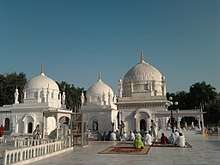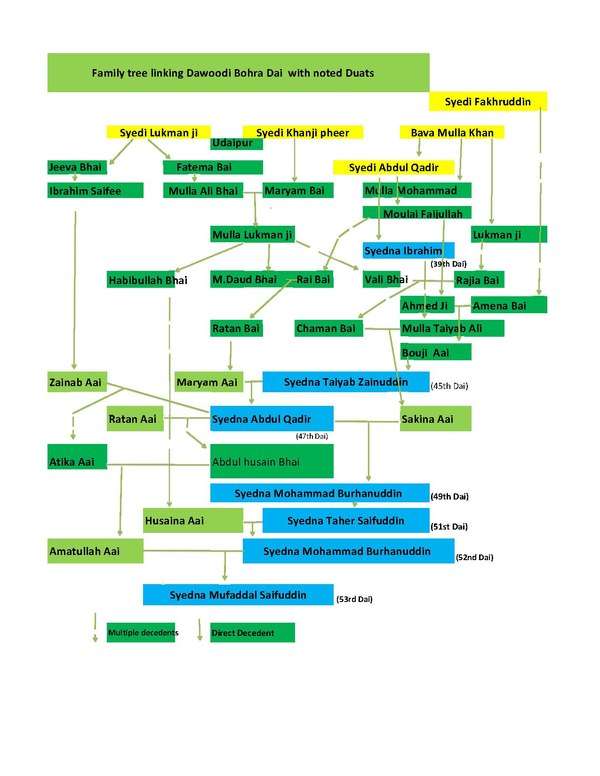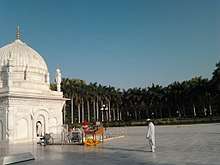Abdul Qadir Hakimuddin
Syedi Abdul Qadir Hakimuddin (1665-1730 AD) is a dawoodi bohra saint who is buried in Burhanpur, India. The tomb complex 'Dargah-e-Hakimi' includes mosques, gardens, and international class accommodation facilities for visitors.[1]

He was born in the period of 34th Dai Syedna Badruddin Bin Mulla Raj on the 14th of Jamadil Awwal 1077 AH (1665 AD).
His father Syedi Bava Mulla Khan visited the court of 35 th Dai Syedna Abdul Taiyeb Zakiuddin in Ahmedabad and presented Saiyedi Abdul Qadir Hakimuddin in ‘Khumus’( one fifth of earning to be presented in the name of god as Mulla Khan was having five son) on the Dai's request. Syedna Safiuddin, son of Syedna Abdul Tayyib Zakiuddin took the responsibility of his education.
He was presented the status of ‘Haddiyat(sheikh)’ by 36th Dai Syedna Kalimuddin . He was made Mukasir Al Dawat by Syedna Noor Mohammed Nooruddin and further elevated to the status of Mazoon (2nd in command) Al Dawat by 38 th Dai Syedna Ismail Badruddin. The 39th Dai Syedna Ibrahim Vajihuddin is the son of Syedi Abdulquadir Hakimuddin.
He was man of literature and composed treasures of the Books of Dawat including "Bulohar" and "Buzazaf".[2] He was a great writer in Urdu, Sanskrit, Persian and Arabic. He translated the contents of some Sanskrit books into Arabic in a book called "Qalila Wadhima".
The 17th-century saint was known for his piety, humility and extreme eruditeness. He came to Burhanpur in his way of preaching Islam. A Hafiz-e-Quran (he could recite the entire Quran from memory) since childhood, his recitation of the Quran could mesmerise any living being. Legend has it that one day while travelling through a forest, he was reciting the Quran when a tiger walked by. The animal sat before the scholar, and quietly walked away once the recitation was over. When Syedi Hakimudin died in 1730 AD (1142 AH, 5th Shawwal), his enemies exhumed his body on some pretext after 22 days, but found to their shock a fresh and fragrant body. Over the years, people's faith grew in Syedi Hakimuddin's miraculous powers. The word hakim denotes a healer and thousands of Bohras flock to his shrine, taking a mannat (vow) for shifa (cure) from disease and seeking restoration of the health of both the body and the soul. It is said that whoever comes here with a prayer on her/his lips, does not go away disappointed. Those who have their prayers answered, their sick loved ones cured, their sinking businesses nursed back to health, and their other problems solved, come back with a generous offering.
Thousands of people are served non-vegetarian food, complete with dessert, tender mutton and basmati rice, with fruit at times.
Dawoodi Bohra 53rd Dai Syedna Ali Qadr Mufaddal Saifuddin and 52nd Dai Syedna Mohammad Burhanuddin and all other Dai starting from 39th Dai are from his family.
| Dua't il-Mutlaqin Ancestry: Moulayi Tarmal, Moulayi Bharmal, and Syedi Hakimuddin | ||||||||||||||||||||||||||||||||||||||||||||||||||||||||||||||||||||||||||||||||||||||||||||||||||||||||||||||||||||||||||||||||||||||||||||||||||||||||||||||||||||||||||||||||||||||||||||||||||||||||||||||||||||||||||||||||||||||||||||||||||||||||||||||||||||||||||||||||||||||||||||||||||||||||||||||||||||||||||||||||||||||||||||||||||||||||||||||||||||||||||||||||||||||||||||||||||||||||||||||||||||||||||||||||||||||||||||||||||||||||||||||||||||||||||||||||||||||||||||||||||||||||||||||||||||||||||||||||||||||||||||||||||||||||||||||||||||||||||||||||||||||||||||||||||||||||||||||||||||||||||||||||||||||||||||||||||||||||||||||||||||||||||||||||||||||||||||||||||||||||||||||||||||
|---|---|---|---|---|---|---|---|---|---|---|---|---|---|---|---|---|---|---|---|---|---|---|---|---|---|---|---|---|---|---|---|---|---|---|---|---|---|---|---|---|---|---|---|---|---|---|---|---|---|---|---|---|---|---|---|---|---|---|---|---|---|---|---|---|---|---|---|---|---|---|---|---|---|---|---|---|---|---|---|---|---|---|---|---|---|---|---|---|---|---|---|---|---|---|---|---|---|---|---|---|---|---|---|---|---|---|---|---|---|---|---|---|---|---|---|---|---|---|---|---|---|---|---|---|---|---|---|---|---|---|---|---|---|---|---|---|---|---|---|---|---|---|---|---|---|---|---|---|---|---|---|---|---|---|---|---|---|---|---|---|---|---|---|---|---|---|---|---|---|---|---|---|---|---|---|---|---|---|---|---|---|---|---|---|---|---|---|---|---|---|---|---|---|---|---|---|---|---|---|---|---|---|---|---|---|---|---|---|---|---|---|---|---|---|---|---|---|---|---|---|---|---|---|---|---|---|---|---|---|---|---|---|---|---|---|---|---|---|---|---|---|---|---|---|---|---|---|---|---|---|---|---|---|---|---|---|---|---|---|---|---|---|---|---|---|---|---|---|---|---|---|---|---|---|---|---|---|---|---|---|---|---|---|---|---|---|---|---|---|---|---|---|---|---|---|---|---|---|---|---|---|---|---|---|---|---|---|---|---|---|---|---|---|---|---|---|---|---|---|---|---|---|---|---|---|---|---|---|---|---|---|---|---|---|---|---|---|---|---|---|---|---|---|---|---|---|---|---|---|---|---|---|---|---|---|---|---|---|---|---|---|---|---|---|---|---|---|---|---|---|---|---|---|---|---|---|---|---|---|---|---|---|---|---|---|---|---|---|---|---|---|---|---|---|---|---|---|---|---|---|---|---|---|---|---|---|---|---|---|---|---|---|---|---|---|---|---|---|---|---|---|---|---|---|---|---|---|---|---|---|---|---|---|---|---|---|---|---|---|---|---|---|---|---|---|---|---|---|---|---|---|---|---|---|---|---|---|---|---|---|---|---|---|---|---|---|---|---|---|---|---|---|---|---|---|---|---|---|---|---|---|---|---|---|---|---|---|---|---|---|---|---|---|---|---|---|---|---|---|---|---|---|---|---|---|---|---|---|---|---|---|---|---|---|---|---|---|---|---|---|---|---|---|---|---|---|---|---|---|---|---|---|---|---|---|---|---|---|---|---|---|---|---|---|---|---|---|---|---|---|---|---|---|---|---|---|---|---|---|---|---|---|---|---|---|---|---|---|---|---|---|---|---|---|---|---|---|---|---|---|---|---|---|---|---|---|---|---|---|---|---|---|---|---|---|---|---|---|---|---|---|---|---|---|---|---|---|---|---|---|---|---|---|---|---|---|---|---|---|---|---|---|---|---|---|---|---|---|---|---|---|---|---|---|---|---|---|---|---|---|---|---|---|---|---|---|---|---|---|---|---|---|---|---|---|---|---|---|---|---|---|---|---|---|---|---|---|---|---|---|---|---|---|---|---|---|---|---|---|---|---|---|---|---|---|---|---|---|---|---|---|---|
| ||||||||||||||||||||||||||||||||||||||||||||||||||||||||||||||||||||||||||||||||||||||||||||||||||||||||||||||||||||||||||||||||||||||||||||||||||||||||||||||||||||||||||||||||||||||||||||||||||||||||||||||||||||||||||||||||||||||||||||||||||||||||||||||||||||||||||||||||||||||||||||||||||||||||||||||||||||||||||||||||||||||||||||||||||||||||||||||||||||||||||||||||||||||||||||||||||||||||||||||||||||||||||||||||||||||||||||||||||||||||||||||||||||||||||||||||||||||||||||||||||||||||||||||||||||||||||||||||||||||||||||||||||||||||||||||||||||||||||||||||||||||||||||||||||||||||||||||||||||||||||||||||||||||||||||||||||||||||||||||||||||||||||||||||||||||||||||||||||||||||||||||||||||

Photo gallery
Dargah-e-Hakimi
 Main entrance Dargah-e-Hakimi
Main entrance Dargah-e-Hakimi Reception dargah -e-Hakimi
Reception dargah -e-Hakimi Residential bungalow for visitor Dargah-e hakimi
Residential bungalow for visitor Dargah-e hakimi Dining hall Dargah-e-Hakimi
Dining hall Dargah-e-Hakimi Dargah -e-Hakimi garden
Dargah -e-Hakimi garden
References
- "Burhanpur". Khandwa.nic.in. 15 August 2003. Archived from the original on 1 February 2013. Retrieved 17 August 2013.
- "Saiyedi Abdul Qadir Hakimuddin (R.A) - Anjuman-e-Najmi". Sfjamaat.org. Retrieved 17 August 2013.
